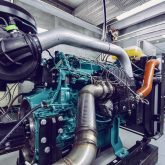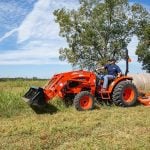At first, the comment seemed counter-intuitive. I was sitting across a small table from Gavin Semple, chair of the Saskatchewan-based Brandt Group of Companies, during Canada’s Farm Progress Show in Regina in June. Semple had just been recognized as the first-ever inductee into the newly created Saskatchewan Manufacturing Hall of Fame, and I wanted to find out from him what it takes to garner professional recognition on that scale.
Semple’s surprising statement was this: “I view myself as just one of 1,800 employees (in his company). We have a lot of people in the company that are a lot smarter than I am that do the heavy lifting every day.”
But after thinking about it, the idea is entirely logical. The recognition that every employee is a potential source of insight or knowledge equal to or better than his own has allowed Semple to leverage their skills and abilities with his own, propelling the company forward.
In the process, they have also helped vault him to prominence among his peers and secure his induction into the hall of fame.
“The success of any business is never due to the efforts of just one person,” Semple went on. “It’s due to the efforts of many. I’m fortunate to have a lot of employees and managers that have been with us for a long time. So this award I received last night, I received on their behalf.”
Today, the Brandt Group of Companies is a diversified manufacturing and equipment retailing business that has an annual turnover of $1.4 billion. But that wasn’t how Semple found it. Less than four decades ago the company was grossing only about $1 million a year.
“I started with the company as a salesman in 1972,” Semple recalled. “I travelled a territory, then became a sales manager the year after, in ’73. And in 1976 I became the president and general manager. At that time we were a small company; we had 25 employees doing about $1 million in sales. We were selling grain augers and machine shop services.”
Read Also

Summer Series: Old machines,new technology
One of my first jobs was working as a mechanic’s helper at a farm equipment dealership in the late 1970s….
Growing Brandt beyond its one-product, regional-manufacturer status first required expanding the variety of equipment rolling out the factory door. Diversification is essential in Semple’s view.
“Over time we expanded our product line and entered new markets, in Canada, the U.S. and around the world,” Semple said. “We (now) have five main companies. We also manufacture rail equipment, pipe handling and testing equipment, and mining. So we’re quite diversified, and that’s stood us in good stead over many years because, as you know, all business cycles. We’re like a farmer who’s growing a variety of crops. You hope the price of crops on average will give you a good return.”
That allowed his organization to cash in on opportunities well beyond its original focus on agricultural machinery manufacturing, including taking on John Deere construction equipment dealerships.
“Brandt Tractor is our largest company and we sell the yellow John Deere equipment — construction and forestry. In 1992 we started with two very small, modest dealerships. The sales and marketing went very well for us, so John Deere gave us the opportunity to acquire other dealerships. So we bought Winnipeg, Calgary and Red Deer in 1995. We (now) have 27 locations.”
Of course, over time inflation and global economic growth have helped fuel increases in the company’s net worth. “When we bought some of those dealerships in Alberta, oil was $12 a barrel,” Semple said.
But he thinks the most critical aspect in the company’s success has been to find ways to create growth within the organization. Simply relying on takeovers to increase revenues doesn’t cut it. And growth, according to Semple, can only happen when a manager has surrounded himself with the right employees.
“The growth has not only come from the acquisitions,” he says, “but from the organic growth after the acquisitions, which is really what’s important to growing a company. And that’s all based around the fundamental belief we have about the importance of people. It’s easy to buy assets like buildings, machinery and so on, but that doesn’t do it for you unless you have a great team of motivated, smart people.”
However, growth involves risk. Why bother?
According to the Bank of Canada, a business such as Brandt that did $1 million in sales in 1973 and continued to operate at the same level would be generating more than $5.23 million today. There’s likely ample revenue in there to keep a pretty nice car parked in the driveway with far fewer headaches.
“No, I don’t think it’s an option,” Semple said, shaking his head. “You’re either growing or dying in my view, because the market is dynamic. It’s changing all the time. Every sector we participate in, we have very good competitors, all of whom want more business.”
“This is my view: If you take the approach of saying I’m comfortable, I don’t want to expand, I don’t want to hire more people, I don’t want to build more buildings or whatever, and if you don’t participate in the market in a competitive way, your competitors will. So they will consume the market and we will shrink.”
Financing the kinds of major acquisitions like those Brandt has swallowed and not exposing the company to excess risk requires a financial strategy, too.
“We did it all through retaining profits,” explained Semple. “We also have some minority partners on the Brandt Tractor side. It’s cautious growth, conservative but aggressive. Conservative and aggressive don’t seem to go together. We watch our balance sheet so as not to take on more debt than we can handle, yet you have to take risks; and you have to take on debt if you’re going to take advantage of opportunities.”
To help create the organic growth that Semple thinks a firm needs to complement its acquisitions, his management approach revolves around four core principles.
“Innovation is very important, but not just innovation in products, although our engineering people focus on that heavily. It’s innovation in the way we do business,” he said. “Innovation is one of our four core values. It’s innovation in everything we do.”
“Quality is our second. Again, that’s quality in everything we do, not just quality in the products. Quality in the people. Quality in the facilities. Quality in our business systems. A focus on quality, so everyone is thinking quality all the time and they won’t compromise when they are making decisions. You have a lot managers when you have 1,800 people, so they’ve got to have some guiding principles.”
“Commitment is another core value. And that’s not only commitment on the part of the employees, we ask them to do whatever it takes to satisfy customers. But it’s also commitment on the part of the shareholders, the owners, my son and I, to continue to invest, to give them the tools, training and technology they need in order to perform at a high level.”
“The final one is customer focus. That’s probably the number one core value that any company needs. It’s to realize all your success comes from your customers, so you better focus on what customers need, what they want, and then be a participant in helping them be successful.”
Achieving hall-of-fame status apparently isn’t luring Semple away from those core values or lulling him into a sense of corporate complacency.
“We’re continuing to expand,” Semple said. “We continue to look for opportunities, both here and elsewhere to grow the business. And we look for synergy — in other words, businesses or products or markets that complement what we’re doing. So when we add one and one we get three. There is a lot of opportunity out there. It’s a matter of choosing the right opportunities.”
And then there is that team of 1,800 employees Semple relies on: “They’re also out there looking for opportunities.”

















